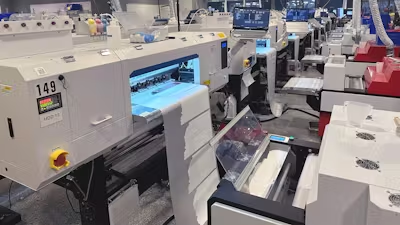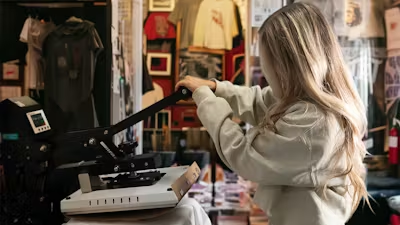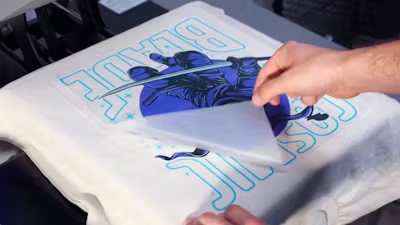'How much does it cost?' is one of the most frequently asked questions about Direct-to-Film (DTF) printing, and for good reason. DTF offers unmatched flexibility and vibrant results, making it a go-to choice for custom apparel. But pinning down the exact cost isn't as straightforward as it might seem. The answer can vary widely with so many variables at play---from order volume to design size to production methods.
We compiled a quick guide that breaks down the costs associated with the main approaches to DTF printing. Whether you're buying individual pre-printed DTF transfers, opting for gang sheets, investing in your own setup, or outsourcing to full-service production, understanding these options will help you find the most efficient and cost-effective path. Let's get into it.

How much does DTF printing cost? The short answers
DTF printing costs can vary widely due to numerous factors such as order size, design complexity, and chosen production method. While it's challenging to provide precise estimates without specific order details, here's a quick overview to give you a general idea of the costs involved in different approaches:
Individual pre-printed DTF transfers
- Small transfers (2"x2") range from $2 each (1-14 pieces) to $0.70 each (250+ pieces).
- Medium transfers (5" x5") range from $4 each (1-14 pieces) to $1.40 each (250+ pieces).
- Larger transfers (11"x11") range from $10 each (1-14 pieces) to $3.50 each (250+ pieces).
Gang sheet of DTF transfers
- A small gang sheet (22" x 24") costs $35 and fits around 30 small designs or 4 large designs. This translates to about $1.15 per small design or $8.50 per large design.
- A medium gang sheet (22" x 120") costs $92 and fits about 150 small designs or 20 large designs.
- A large gang sheet costs $150 and fits about 300 small designs or 40 large designs. This translates to about $0.50 per small design or $3.75 per large design.
Printing the DTF transfers yourself
Initial setup costs range from $5,000 to $20,000, including the printer, heat press, powder shaker, air filter, and supplies. We will break down these costs in more detail later.
Ordering full production printing services
Full-service printing costs around $5 to $20 per shirt, depending on order size and print locations.

Now that you have a general idea, we can discuss the costs of different approaches in more detail and include more factors, such as the cost of t-shirts and production costs.
Full Breakdown
In this section, we explore the true costs of pre-printed transfers, full-service DTF production, and setting up an in-house printing operation. Many variables are involved, including quantities, apparel types, and operation costs. We've broken this down to help you compare costs side by side.
Cost pre-printed DTF transfers
Ordering pre-printed DTF transfers is an excellent option for many, especially individuals and businesses not ready to invest heavily in printing equipment. The cost elements involved when opting for pre-printed transfers include the price of materials and the labor associated with heat pressing these designs onto blank apparel.
Cost breakdown
- Blank shirts are the base for your DTF transfers. Costs vary by shirt quality and the quantity purchased, but standard Next Level 3600 shirts will cost around $5.50 each for 100 shirts and approximately $4 each for 1000 shirts.
- Pre-printed DTF transfers: Depending on the design complexity and size, transfers can range from a few cents to several dollars per piece. Bulk ordering can significantly reduce costs.
- Heat press: If not already owned, a heat press is a necessary investment, ranging from $300 to $1,000, depending on size and features.
- Supplies and accessories: Items such as thermal tape, alignment ruler guide, cutting mat, and blower are small but essential investments, typically totaling around $50-$100. Order your discount DTF supplies here, or learn more about the various accessories.
- Labor and time: The pressing process itself isn't overly time-consuming but requires effort and precision. Labor costs will vary depending on whether you do it yourself or hire help.
Example pricing scenarios
- Sample order (10 shirts): This is ideal for testing designs or market response before scaling up. The shirt costs $6 per shirt and the individual size transfer sheets are $9 each. The total cost is $150, which is about $15 per shirt. This higher per-unit price reflects the lower economies of scale but allows for flexibility and minimal risk investment.
- Small scale (100 shirts): With a base shirt cost of $575 and transfers priced at $300 for two large gang sheets, total material costs amount to $875. Including a modest labor charge and supplies, the total might be around $900, breaking down to $9 per shirt.Large scale (1000 shirts): Bulk discounts reduce the shirt cost to $5000, resulting in significant savings per shirt, potentially under $6 each when factoring in economies of scale on labor and materials.
Pro tip: Ordering gang sheets will significantly reduce the cost of each individual DTF transfer. They arrive in a roll; the only tradeoff is that you must cut them into individual transfers yourself. You can use our gang sheet builder to set up an assortment of individual files or upload your own gang sheet in vector format.

Pros of pre-printed transfers
- Flexibility: Experiment with various shirt materials and print locations without committing to bulk orders. You can also print multiple print locations with minimal cost-per-piece increase.
- On-demand printing lets you respond quickly to market trends or customer requests with minimal delay. DTF transfers can be easily and safely stored for long periods of time.
- Low-risk testing: Gauge market reception of new designs without large upfront investments.
- Quality control: Outsource printing while maintaining control over the heat-pressing process.
Cons of pre-printed transfers
- Initial equipment cost: Acquiring a heat press is necessary for transferring designs onto apparel.
- Labor and time: Heat pressing requires time and labor, which can add up for larger orders.
- Higher cost per piece: Pre-printed transfers generally cost more per unit than in-house DTF production.

Costs of full-service DTF production
Choosing full-service DTF production and leaving the entire task to the pros allows you to focus on other aspects of your business while ensuring top-quality results. This approach is perfect for businesses that prefer not to deal with the operational complexities of printing and pressing but still want to offer high-quality customized apparel. Below, we break down the costs of entrusting your printing needs to a full-service provider like Ninja Printhouse.
Cost breakdown
- Comprehensive service includes everything from initial design proofing and artwork adjustments to final printing and pressing. Full-service means professionals handle every detail.
- Material and production costs: These are generally included in the price quote and cover everything from the shirts and DTF transfers to the use of high-end equipment. We're using the same standard Next Level 3600 shirt for the examples below. Choosing a budget or premium tee will significantly change the overall cost. Learn more about choosing the right products.
- Shipping costs: Shipping costs can vary depending on your location and order size and are sometimes rolled into the overall service cost.
- Bulk order efficiency: With economies of scale, costs decrease as order size increases.
Example pricing scenarios
- Sample order (10 shirts): This is ideal for initial testing or small, custom batches. The total comes to around $235 at $23.50 per shirt. This rate reflects the premium for low-volume, high-quality, custom production, making it perfect for exclusive releases or high-end fashion samples.
- Small scale (100 shirts): This option suits small businesses or events. With complete production services, the cost per shirt is $13.68, totaling around $1,368 plus shipping. This includes handling everything from printing to quality control, providing a hassle-free solution.
- Large scale (1000 shirts): For enterprises or large events, the bulk order significantly reduces the unit price to around $10 per shirt, amounting to $10,090. This reflects the cost efficiencies gained through larger production scales, making it an economical choice for extensive merchandising.
Pro tip: You can use the built-in quote calculator when placing an order through most major print shops, including Ninja Printhouse. Upload your design, then change the product and quantity to see a real-time quote. This allows you to adjust your order to fit your specific needs and budget.

Pros of full-service production
- Convenience: Delegate the entire production process to experts, allowing you to focus on marketing and sales.
- Consistent quality: Ensure professional results with experienced operators using state-of-the-art equipment.
- No equipment costs: Eliminate the need for upfront investments in production equipment and infrastructure.
- Streamlined process: Benefit from a hassle-free, efficient production process managed by the service provider.
Cons of full-service production
- Limited flexibility: The service provider's capabilities and offerings may be constrained by product range and print locations.
- Potential for excess inventory: Bulk ordering can result in surplus stock if products do not sell as anticipated, tying up capital and storage space.
- Reduced control: Less hands-on involvement in production than in-house operations.
- Higher per-unit costs: Full-service production often has higher per-unit costs than in-house production, especially at larger scales.

Cost of setting up an in-house DTF printing operation
Setting up an in-house DTF printing operation appeals to businesses prioritizing full control over their production process and maximizing profitability over time. This approach involves a significant initial investment and ongoing operational management but can lead to greater long-term savings and flexibility. Here are the detailed cost factors and scenarios associated with establishing your own DTF printing setup.
Initial investment
-
Equipment costs:
- DTF Printer: Prices can range from $1,500 to $15,000, depending on the model and capabilities. Some cheap consumer-level printers are available, but we don't recommend them for any use cases at scale.
- Heat Press: Essential for curing transfers, with costs between $300 and $1,000+.
- Powder Shaker/Dryer: Typically around $1,500 for entry-level systems.
- Air Filter/Ducting: Necessary for ventilation, costing about $500.
- Installation and Shipping: An additional $100 to $200 may be added.
-
Supplies and consumables:
- Transfer Film: Costs can be as low as .25 per large sheet when buying DTF film rolls.
- DTF Inks: Approximately $80 per liter.
- Transfer Powder: Around $40 per kg bag.
-
Operational costs:
- Maintenance: Regular maintenance can cost around $50 weekly.
- Labor: Depending on the scale, labor can be a significant expense, particularly for design, pre-treatment, printing, and quality control.
Cost breakdown scenarios
-
Small-scale operation (producing up to 50 shirts per week):
- Initial equipment investment might average $6,450.
- Depending on production volume, monthly consumables and operational costs could run around $500.
-
Medium-scale operation (producing up to 500 shirts per week):
- Larger equipment and higher volume supplies might increase initial costs to about $15,000.
- Monthly running costs, including labor and consumables, could average $2,000.
-
Large-scale operation (producing over 1000 shirts per week):
- Industrial-scale equipment might require an investment of over $30,000.
- Ongoing monthly costs for materials, labor, and maintenance might exceed $5,000.
Example cost per print
The cost per print can vary significantly based on the scale of operations and the efficiency of the process. Small operations might range from $3 to $5 per print, whereas large operations might reduce the cost to under $2 per print.

Pros and cons of setting up an in-house DTF printing operation
Establishing an in-house DTF printing operation is a significant investment that can greatly impact your business's scalability and control over production. This section examines both the benefits and challenges of building your own DTF setup, helping you make an informed decision based on your company's goals.
Pros
- Control and customization: Having an in-house DTF printing setup provides complete control over the production process, from design to final product. This allows for immediate adjustments and customization, catering to specific client requests or quickly adapting to market trends without depending on external suppliers.
- Cost efficiency at scale: While the initial investment is significant, the per-unit cost of printing decreases as production volume increases. Over time, this can lead to substantial cost savings, especially for businesses that consistently produce high volumes of prints.
- Speed and flexibility: In-house operations enable quicker turnaround times since the entire production cycle---from printing to heat pressing---is managed onsite. This speed can be a crucial advantage in a market that values fast delivery times.
- Quality control: Direct oversight of the printing process ensures a consistently high output quality, reducing the risk of errors and customer dissatisfaction that can occur when outsourcing.
Cons
- High initial investment: The upfront cost of purchasing high-quality DTF printers, heat presses, and other necessary equipment can be prohibitive for small businesses or startups. This includes the cost of space and infrastructure needed to house the equipment.
- Maintenance and operational complexity: Running an in-house DTF operation requires technical knowledge and regular maintenance to keep equipment running efficiently. This complexity adds an additional layer of operational demands that not all businesses can handle.
- Resource-intensive: Besides equipment, significant resources must be devoted to training staff, managing inventory, and ongoing operational costs, such as electricity, maintenance, and consumables like inks and transfer film.
- Risk of overproduction: Owning a DTF printing setup could lead to overproduction or excess inventory if demand is not accurately forecasted. This can tie up capital in unsold stock and increase storage costs.

Cost comparison and decision-making
Selecting the optimal DTF printing approach hinges on your business objectives, available resources, and intended scale of operation. The following scenarios will help you determine the most suitable option for your specific needs.
Pressing Your Own DTF Transfers
Pressing your own DTF transfers is a compelling choice for individuals, small businesses, or those entering the custom apparel market. With relatively low overhead costs, primarily the investment in a heat press, this approach offers hands-on control and flexibility in production volume and scheduling. It's particularly well-suited for:
- Entrepreneurs and side hustlers test the market with limited designs or custom orders, enabling high-quality production without substantial upfront costs.
- Small businesses with fluctuating product demand or those offering limited edition runs ensure quick response to customer requests without significant financial commitments.
Outsourcing to Full-Service Production
Full-service DTF printing providers like Ninja Printhouse are ideal for those prioritizing design and sales, entrusting the technical aspects of production to experts. This option is especially beneficial if you:
- Lack the technical expertise or interest in the production process. Allows you to focus on marketing and business development.
- Require consistent, high-quality results, with professionals handling every step to meet your specifications and quality standards.
- Need scalability without risk, as full-service providers can accommodate increased order volumes without additional investments in equipment or space.
Establishing an In-House DTF Printing Operation
Building a complete in-house DTF printing operation is appropriate for businesses aiming to scale significantly and potentially expand into selling DTF transfers. This option is most viable if you:
- Plan to handle high volumes, ensuring efficient fulfillment of customer demand for numerous prints or print-on-demand services.
- Seek to maximize profit margins, as controlling the entire production process can lead to lower per-unit costs and improved margins as volumes increase.
- Want complete creative and operational control, allowing for experimentation with designs and production techniques, ideal for businesses emphasizing innovation and customization.
Our recommendation: We encourage those new to DTF printing to consider pressing their own DTF transfers. It's easy, enjoyable, and provides a way to achieve professional and highly customized results with minimal investment and effort. It also gives you a hands-on understanding of this innovative technology for custom printing on anything. This method is perfect for many use cases, from launching new clothing lines to creating personalized items for events and promotions.

Choosing the right DTF printing approach for your business
For entrepreneurs, side hustlers, and small businesses, pressing your own DTF transfers provides an accessible entry point into the custom apparel market, allowing for hands-on control and low-risk experimentation.
If your focus is on design and marketing, outsourcing to a reliable full-service provider ensures consistent, high-quality results without requiring technical expertise or significant upfront investments.
As you grow and seek to maximize profitability and creative control, setting up an in-house DTF printing operation becomes attractive. This approach enables you to handle high volumes, reduce per-unit costs, and expand your offerings to include selling DTF transfers.
The right path for you is the one that aligns with your goals and capabilities. Whether you choose to press your own transfers with top-quality supplies from Ninja Transfers, entrust your production to the experts at Ninja Printhouse, or establish your own operation with equipment and supplies from Ninja Blanks, you can be confident in the power of DTF printing to elevate your custom apparel business to new heights.






































